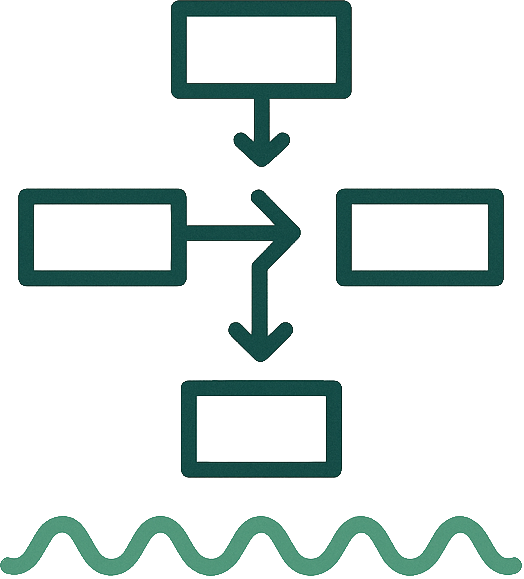The Mid-Sized Business Owner’s
Guide to Software Success
Go Live Now, scale with confidence, and get real ROI from your software investments.
Last updated: 2025-11-11T21:15:02.352Z
Table of Contents
- Introduction — Why Software Projects Fail
- Best Practices for Working With a Software Team
- How to “Go Live Now” Without Risking It All
- Designing for Scalability with Event Modeling
- ROI: Custom Software vs Off-the-Shelf
- What to Demand From Software Partners
- Appendix: Software Project Kickoff Checklist
- About Joey G.
Introduction — Why Software Projects Fail (and What to Do Differently)
Most projects don’t fail because of code. They fail because of misalignment—weak communication, thin feedback loops, and decisions made on assumptions instead of evidence.
- Lack of visibility: work happens in a black box and surprises show up late.
- Overpromising & underdelivering: optimistic timelines and thin budgets mask risk.
- No single owner: teams ship features that “work” technically but miss business value.
In this guide you’ll learn how to go live now—safely—in small, valuable increments; how to manage risk with phased rollouts; and how to design for scalability using Event Modeling.






Best Practices for Working With a Software Development Team
Communicate like you’re on the same team. Demand visibility. Break the work into small, testable pieces. Document as you go. Choose partners, not vendors.
| Practice | Why it matters |
|---|---|
| Weekly demos | See working software, not just status updates. |
| Single channel | Keep decisions in one place—avoid scatter. |
| Decision owner | Define who approves scope, sequencing, releases. |
| Incremental delivery | Prototype in weeks, not months. Learn, adjust, expand. |
| Documentation | Diagrams, API notes, deployment steps—insurance against turnover. |
How to “Go Live Now” Without Risking It All
Redefine “go live” as shipping a small, working, valuable slice to real users. Avoid the big-bang reveal. Learn from production-like feedback while protecting your reputation.
- Start small, but real — one feature, one team, one workflow.
- Design for evolution — each release adds capability without breaking what came before.
- Celebrate value, not volume — measure ROI as reduced friction, time saved, accuracy improved.
Phased rollouts reduce risk and build trust through predictable progress.
Designing for Scalability with Event Modeling
Event Modeling maps your business as a series of facts: events that happened. Instead of starting with tables and fields, start with the behavior of your system.
- Change is additive: add new event types instead of rewriting schemas.
- History is preserved: every event is a permanent record.
- Horizontal growth: slice workflows and scale services independently.

The ROI of Custom Software vs. Off‑the‑Shelf Tools
Off‑the‑shelf tools are great to start. As you scale, integration drag and process contortions become a tax. Custom software is an investment that compounds.
| Situation | Buy | Build |
|---|---|---|
| Commodity tools (email, payroll, CRM) | ✅ | |
| Core operations that make you unique | ✅ | |
| Still validating process | ✅ | |
| Stable, proven workflows | ✅ | |
| Cross‑department integration | ✅ | |
| Compliance / audit needs | ✅ |
ROI reflection: What’s the real cost of your current workarounds (manual re‑entry, delays, lost accuracy)?
What to Demand From Your Software Partners
- Transparency Over Theater: weekly working demos, visible backlog, environment access.
- Curiosity About Your Business: they ask “why” and map value, not just tickets.
- Shared Accountability: clear success metrics, post‑launch support, honest estimates.
- Incremental Value: go live now, in slices. Fast feedback, compounding ROI.
- Design for Change: event‑first architecture that evolves without rewrites.
- Clarity on Cost & Continuity: own the code, keep docs current, plan for updates.
Appendix — Software Project Kickoff Checklist
Align on Goals and Outcomes
- What business problem are we solving?
- What does success look like in measurable terms?
- Who are the end users and how does this help them?
- What’s the V1 must‑have vs nice‑to‑have?
Define Roles and Responsibilities
- Single point of contact on your side.
- Delivery owner on the development team.
- Blocker/decision communication path.
- Who signs off on milestones and releases?
Establish Communication Cadence
- Standups, weekly demos, written updates.
- Tools: Slack/Teams/email; single source of truth.
- After‑hours emergencies protocol and escalation path.
Transparency & Deliverables
- Weekly working software.
- Progress tracking: board/burndown/checklists.
- Definition of Done per feature.
- How decisions are documented.
Risk & Budget Management
- Realistic vs optimistic timeline.
- Payments tied to deliverables.
- Fallback plan if deadlines slip.
- Scope change estimation/approval.
Deployment & Support
- Hosting/infrastructure ownership.
- Testing & QA plan.
- Rollout strategy: pilot → phased → general.
- Post‑go‑live support owner.
Scalability & Continuity
- Event‑first design to evolve with growth.
- Architecture/API documentation.
- Avoid lock‑in; portable knowledge sharing.
- Plan for updates & maintenance.
About Joey G.
I help mid‑sized businesses scale operations without growing the back office. My Go Live Now approach focuses on small launches, fast learning, and systems designed for change.
[email protected]
